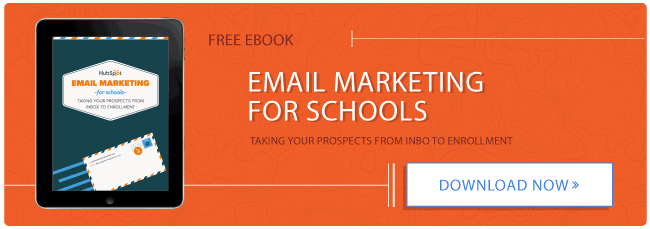
You're ready to get your inbound marketing machine going. You've read the case studies and statistics showing how effective inbound marketing is at pulling together a full enrollment class.
And then you start thinking about the all the different strategies and tactics and new social media platforms and metrics and... Holy cow, it can all seem to be a bit much. Where is a small education marketing team to start?
Well, we'll tell you. Here are some guidelines to follow so you can get started with your own inbound marketing plan.
Start with the Baby Steps
We all have to walk before we run. Don't think about the full volume of what inbound marketing can do for you and all the options you have under the rubric of inbound marketing. Finding a focus can be especially difficult for new schools and programs, or independent schools, that don't have a pre-existing marketing framework to use as a reference point. So for starters, put your focus on taking action.
When you're first starting, your immediate goal is to take consistent action. Set some milestones, such as publishing one blog post a week and making one new offer a month. Hitting these milestones will create habits and build skills your team will need to grow your inbound marketing chops, refining your workflows so all their underlying tasks become easier to execute over time.
Focusing first on taking consistent action will also let you establish a baseline of your efforts' performance, which you can then use to set more results-oriented goals in the future.
As a very first step, create your personas (this free template can help). Inbound marketing always starts with the right personas. Putting together persona profiles forces you to investigate who your target market really is, what they care about, what they want to know, and where they're getting their information.
Get Some Quick Wins
You can tap into existing resources to quickly hit your action milestones. If you already publish a blog, review your current posts in light of your new persona profiles. For posts on topics that meet your personas' needs, freshen them up with a new, improved keyword strategy. Update them with more current information. If your persona process revealed that your blog has been focusing on the wrong topics, time to change course with your posts.
You can find a lot of good, relevant blog content in materials the school already has. Go through different department newsletters, course syllabi, or admissions materials. Use them as starting points to generate some new blog posts quickly.
Want some quick wins with your content offers? Take a look back at your old content offers. Pick one that best fits what you know about your new personas. Freshen up the content if needed with updated information or new graphics. Spruce up some new CTAs to place on your website and to promote via social media.
A great first choice for creating a new content offer is to look at who's already in your database. Do you have a sluggish, un-engaged pool of emails? Put together a re-engagement campaign for them.
For additional email tips, take a look at this free guide >>
Whatever you decide your quick wins will be, here's a library of 360+ templates you can use to quickly create great looking content.
Looking to the Bigger Picture
Once you feel like you've started some good habits and met your small milestones, it's time to move one step further and do a little planning for the future.
For your blog, this means brainstorming a list of 30-40 blog topics. Don't do this on your own. Bring in people from admissions, perhaps a faculty member and student or two. With a working list of blog topics, ramp-up your publication schedule. For the first time, set a goal of publishing 2-3 posts every week. At this pace, your topic list will keep you running for a quarter. For your next brainstorm session, you can ramp these numbers up even further.
This is also a good time to take another look at your social media platforms. Which ones are really worth your effort? Perhaps you should keep some for student and prospect communications only. Learn which channels parents and potential employment sources gravitate to and reach out to them with content that keeps them interested in your campus.
Clarify which social media platforms deserve your focus, and who you're trying to reach with each of them. Then optimize your profile, and set up templates and best practices for each one. Your social media profiles are distribution force multipliers, so make sure they're getting your message out.
This is also the time to expand your vision beyond driving traffic to your website. Your goal has never been simply to get traffic. It's time to convert some of your website visitors into prospects and get their email address into your database. You do this through a stellar content offer, say a guide to your academy's applicant assessment process or the scholarships available at your school that motivates people to give you their email address to get it.
With their email address in your database, you now have options to target them further with content that pushes them down the enrollment funnel.
No Actions is Too Small
However small your baby steps are, take them now. Inbound marketing builds on itself. Whatever small changes you make now will continue to provide benefits well down the line. Blog posts you publish now will continue to draw traffic over the years. Out of the blue, someone will retweet one of your content offers months after you sent it out. You might warn students that "the Internet is forever," but when it comes to inbound marketing – this can be a great plus.
Another great advantage to inbound marketing is everything that you can learn from every single action you take. Every. Single. One. You'll learn more about your market, about what works with them and what doesn't. You can build each subsequent email series or blog editorial calendar on better intel. You'll also improve your own internal workflows that will help you generate more content more quickly.
Inbound marketing creates a continuous, virtual cycle the pushes everything forward with greater momentum the longer you do it. But first, you've got to get started. Want a more detailed action plan? Here's an inbound plan for your first 100 days.
from HubSpot Marketing Blog http://blog.hubspot.com/marketing/how-can-small-schools-tackle-inbound-marketing
Via http://blog.hubspot.com/marketing/how-can-small-schools-tackle-inbound-marketing

No comments:
Post a Comment